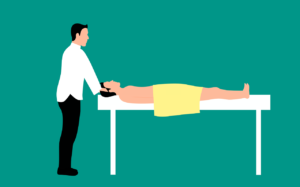
Are you tired of waking up in the morning with that uncomfortable tingling sensation in your arm? Look no further, because we have the solution for you! In this article, we will explore some simple techniques that can help prevent numbness and tingling in your arm while side sleeping. So say goodbye to restless nights and hello to a peaceful slumber. Get ready to discover the secrets to a comfortable and uninterrupted sleep!

Choosing the Right Pillow
Invest in a supportive pillow
When it comes to preventing numbness and tingling in your arm while side sleeping, investing in a supportive pillow can make a big difference. Look for a pillow that provides adequate support for your neck and head, helping to align your spine and prevent unnecessary strain on your arm. A supportive pillow will help distribute your body weight more evenly, reducing the likelihood of discomfort and numbness.
Opt for a contoured pillow
Another option to consider is a contoured pillow. These pillows are specifically designed to provide support and alignment for your neck and spine, which can help alleviate pressure on your arm while side sleeping. The contoured shape of the pillow helps cradle your head and neck, promoting proper alignment and reducing the risk of numbness and tingling.
Consider a memory foam pillow
Memory foam pillows are known for their ability to conform to the shape of your head and neck, providing personalized support and pressure relief. This can be particularly beneficial for side sleepers who are prone to arm numbness and tingling. The memory foam material allows the pillow to contour to the curves of your body, reducing pressure points and promoting better circulation, resulting in a more comfortable and restful sleep.
Proper Sleeping Position
Position your arm properly
One of the causes of arm numbness and tingling while side sleeping is placing your arm in an awkward position that can compress nerves and restrict blood flow. To prevent this, make sure to position your arm properly while sleeping on your side. Try to keep your arm parallel to the floor and avoid bending it at the wrist or elbow. This can help relieve pressure on the nerves and prevent numbness and tingling.
Avoid putting weight on your arm
Another important consideration is to avoid putting too much weight on your arm while side sleeping. If your arm is under your pillow or body, the pressure can cause compression of the nerves and blood vessels, leading to numbness and tingling. Try to keep your arm free and relaxed, allowing for unrestricted blood flow and avoiding unnecessary pressure.
Try different sleeping positions
If you consistently experience arm numbness and tingling while side sleeping, it may be worth trying different sleeping positions to find one that works better for you. Experiment with sleeping on your back or stomach, as these positions may alleviate the pressure on your arm and reduce the risk of numbness and tingling. Finding the right sleeping position can greatly contribute to a more comfortable and restful sleep experience.

Maintaining Good Posture
Practice proper posture during the day
Maintaining good posture throughout the day is crucial in preventing arm numbness and tingling while side sleeping. Poor posture can contribute to muscle imbalances and compression of nerves, leading to discomfort and numbness. Make a conscious effort to sit and stand with your shoulders back, chin parallel to the floor, and spine in a neutral position. Practicing good posture during the day will help alleviate strain on your upper body and reduce the likelihood of arm numbness during sleep.
Engage in regular stretching exercises
Stretching is an excellent way to relieve tension and maintain flexibility in your muscles and joints. Incorporating regular stretching exercises into your daily routine can help improve your overall posture and reduce the risk of arm numbness while side sleeping. Focus on stretches that target your neck, shoulders, and upper back to release tension and improve mobility. Consult with a healthcare professional or physical therapist for personalized stretching recommendations.
Strengthen your upper body muscles
Strengthening your upper body muscles can help support proper posture and reduce the likelihood of arm numbness and tingling while side sleeping. Engaging in exercises that target your shoulders, arms, and upper back can help improve muscle strength and endurance. Consider incorporating exercises like shoulder presses, rows, and push-ups into your fitness routine. Remember to start with light weights and gradually increase intensity to avoid strain or injury.
Adjusting Bedding and Mattress
Check mattress firmness and support
The firmness and support of your mattress can play a significant role in preventing arm numbness and tingling while side sleeping. A mattress that is too soft may cause your body to sink, putting pressure on your arm and leading to discomfort and numbness. On the other hand, a mattress that is too firm may not provide adequate cushioning, resulting in increased pressure points. Finding the right balance is vital, and investing in a mattress with medium firmness and proper support can greatly improve your sleep quality.
Place a pillow under your arm
Placing a pillow under your arm while side sleeping can provide additional support and alleviate pressure on your arm, reducing the risk of numbness and tingling. Choose a pillow that is sufficiently thick and firm to lift your arm slightly and maintain a neutral position. This can help improve circulation and prevent compression of nerves and blood vessels. Experiment with different pillow sizes and materials to find the most comfortable and supportive option for you.
Use an adjustable bed
An adjustable bed can be a valuable investment for those struggling with arm numbness and tingling while side sleeping. These beds allow you to customize the angle and elevation of your upper body, providing optimal support and alignment. By adjusting the bed to a position that reduces pressure on your arm, you can significantly improve your sleeping posture and alleviate discomfort. Consider exploring different adjustable bed options to find one that suits your specific needs.

Using Arm Support
Try a pillow between your arms
Placing a pillow between your arms while side sleeping can provide additional support and promote better alignment of your shoulders and spine. This can be particularly beneficial in preventing arm numbness and tingling. The pillow acts as a cushion, helping distribute the weight of your upper body and reducing pressure on your arm. Experiment with different pillow sizes and materials to find the most comfortable and effective arm support option for you.
Use an armrest or cushion
If you struggle with arm numbness and tingling while side sleeping, using an armrest or cushion can help alleviate pressure and improve your sleeping position. These products are designed to provide support and cushioning for your arm, reducing the risk of discomfort and numbness. Choose an armrest or cushion that is adjustable and allows you to position your arm in a way that promotes proper alignment and reduces strain.
Consider a specialized arm support pillow
For individuals experiencing persistent arm numbness and tingling, specialized arm support pillows can be a beneficial option. These pillows are specifically designed to provide targeted support to the arm and shoulder, reducing pressure and improving circulation. They often feature unique contours and materials that conform to your body shape for maximum comfort and support. Explore different options available on the market and find one that suits your needs and preferences.
Considerations for Pregnancy
Use pregnancy pillows
During pregnancy, the body undergoes numerous changes that can increase the risk of arm numbness and tingling while side sleeping. Using pregnancy pillows can help alleviate these discomforts and promote better sleep. Pregnancy pillows are designed to provide support for the growing belly and help maintain proper alignment of the spine, reducing pressure on the arm. Look for pregnancy pillows that are versatile and can be adjusted to fit your changing needs throughout different stages of pregnancy.
Avoid putting pressure on your belly
As your pregnancy progresses, it’s important to avoid putting unnecessary pressure on your belly while side sleeping. This pressure can restrict blood flow and compress nerves, leading to arm numbness and tingling. Use pillows or cushions to support your belly and alleviate pressure. Experiment with different sleep positions, such as sleeping with a body pillow or using pillows to elevate your upper body slightly, to find the most comfortable and supportive position for you and your baby.
Consult with your healthcare provider
If you experience persistent arm numbness and tingling during pregnancy, it’s important to consult with your healthcare provider. They can evaluate your symptoms, provide personalized recommendations, and ensure there are no underlying medical conditions contributing to your discomfort. Your healthcare provider may also refer you to a physical therapist who specializes in treating pregnant individuals, who can provide further guidance and recommend exercises or therapies to alleviate your symptoms.

Exercising and Stretching
Perform regular shoulder and neck stretches
Incorporating regular shoulder and neck stretches into your exercise routine can help prevent arm numbness and tingling. These stretches help improve flexibility, relieve tension, and promote better posture, reducing the risk of compression on nerves and blood vessels. Simple exercises like shoulder rolls, neck tilts, and upper trapezius stretches can be done daily to maintain mobility and alleviate muscle imbalances. Remember to warm up before stretching and perform each stretch gently without any pain or discomfort.
Strengthen your arm muscles
Strengthening your arm muscles through targeted exercises can help support proper alignment and reduce the risk of arm numbness and tingling. Focus on exercises that target your biceps, triceps, and forearm muscles to improve strength and stability. Examples include bicep curls, tricep dips, and wrist curls. Gradually increase the intensity and resistance as your muscles become stronger. Consult with a fitness professional or physical therapist for guidance and personalized recommendations.
Include exercises that improve circulation
Exercises that promote circulation can be beneficial in preventing arm numbness and tingling. Cardiovascular exercises like walking, jogging, cycling, or swimming help improve blood flow throughout your body, including your arms. This increased circulation delivers oxygen and nutrients to your muscles, reducing the risk of numbness and tingling. Aim for at least 150 minutes of moderate-intensity cardio exercise each week, or as recommended by your healthcare provider. Remember to start slowly, listen to your body, and gradually increase the intensity over time.
Maintaining a Comfortable Sleep Environment
Control room temperature and humidity
Creating a comfortable sleep environment is essential for preventing arm numbness and tingling while side sleeping. The temperature and humidity of your bedroom can greatly affect your comfort and sleep quality. Optimal room temperature for most people ranges between 60 and 67 degrees Fahrenheit (15 to 19 degrees Celsius) and humidity levels around 40 to 60 percent. Experiment with different settings to find what works best for your preferences and use fans or humidifiers to adjust the conditions accordingly.
Use breathable bedding materials
Choosing breathable bedding materials can help regulate your body temperature and prevent excessive heat or moisture buildup. Look for bedding made from natural fibers, such as cotton or bamboo, as they tend to be more breathable and wick away moisture. This can help prevent discomfort and excessive sweating, which can contribute to arm numbness while side sleeping. Keep your bedding clean and fresh, and consider using a mattress protector to maintain a hygienic and comfortable sleep environment.
Keep the sleeping area free from clutter
Clutter in your sleeping area can contribute to poor sleep quality and discomfort while side sleeping. Remove any unnecessary items from your bed or nearby surfaces to create a peaceful and clutter-free sleep environment. This will not only reduce the risk of accidentally putting pressure on your arm but also promote better relaxation and a more restful sleep. Keep your bedroom clean and organized to create a calming space that promotes optimal sleep.

Seeking Medical Advice
Consult with a healthcare professional
If you have tried various strategies but continue to experience arm numbness and tingling while side sleeping, it is important to consult with a healthcare professional. A healthcare professional can evaluate your symptoms, perform any necessary tests or examinations, and provide personalized advice and recommendations based on your specific situation. They can help identify any underlying medical conditions contributing to your symptoms and guide you towards the most appropriate treatment options.
Consider physical therapy
Physical therapy can be a valuable option for individuals experiencing arm numbness and tingling while side sleeping. A physical therapist can evaluate your posture, muscle imbalances, and movement patterns, and provide targeted exercises and techniques to alleviate your symptoms. They can also address any underlying issues contributing to your discomfort and teach you how to properly position your body during sleep. Physical therapy can help improve your overall strength, flexibility, and posture, leading to better sleep quality and reduced arm numbness.
Explore alternative therapies
In some cases, alternative therapies may be recommended to help manage arm numbness and tingling. These therapies can include chiropractic care, acupuncture, or massage. Chiropractic adjustments aim to improve spinal alignment and reduce nerve compression, while acupuncture targets specific points in the body to promote better energy flow. Massage can help relieve tension and improve circulation, reducing the risk of numbness and tingling. Consult with a healthcare professional to discuss which alternative therapies may be suitable for your individual needs.
Taking Breaks Throughout the Day
Avoid prolonged periods of arm pressure
To prevent arm numbness and tingling, it’s crucial to avoid prolonged periods of arm pressure throughout the day. If your work or daily activities require leaning on your arms for an extended period, take frequent breaks to relieve the pressure. Stand up, stretch, and move around to promote better circulation and reduce the risk of compression on nerves and blood vessels. Incorporating regular breaks into your routine can help prevent and alleviate arm numbness and tingling.
Change positions frequently
Sitting or standing in the same position for an extended period can contribute to arm numbness and tingling. To prevent this, make a conscious effort to change positions frequently throughout the day. Shift your weight, adjust your sitting or standing posture, and engage in regular movement and stretching breaks. This will help prevent the buildup of pressure and reduce the risk of arm numbness and tingling. Listen to your body and pay attention to any signs of discomfort or tingling, and take action to alleviate the pressure.
Take short breaks from repetitive tasks
Repetitive tasks can put strain on your arm muscles and increase the risk of arm numbness and tingling. If your work or hobbies involve repetitive motions, take short breaks to rest and stretch your arm muscles. This can help reduce muscle fatigue and the risk of overuse injuries, which can contribute to arm numbness. Incorporate simple stretching exercises, such as wrist and finger stretches, into your break routine to promote flexibility and reduce tension.
By implementing these strategies and making adjustments to your sleeping position, posture, bedding, exercise routine, and daily habits, you can significantly reduce the risk of arm numbness and tingling while side sleeping. Remember to consult with a healthcare professional for personalized advice and recommendations based on your specific needs and condition. Prioritizing your sleep and overall well-being by taking proactive measures can lead to a more comfortable and restful night’s sleep.







